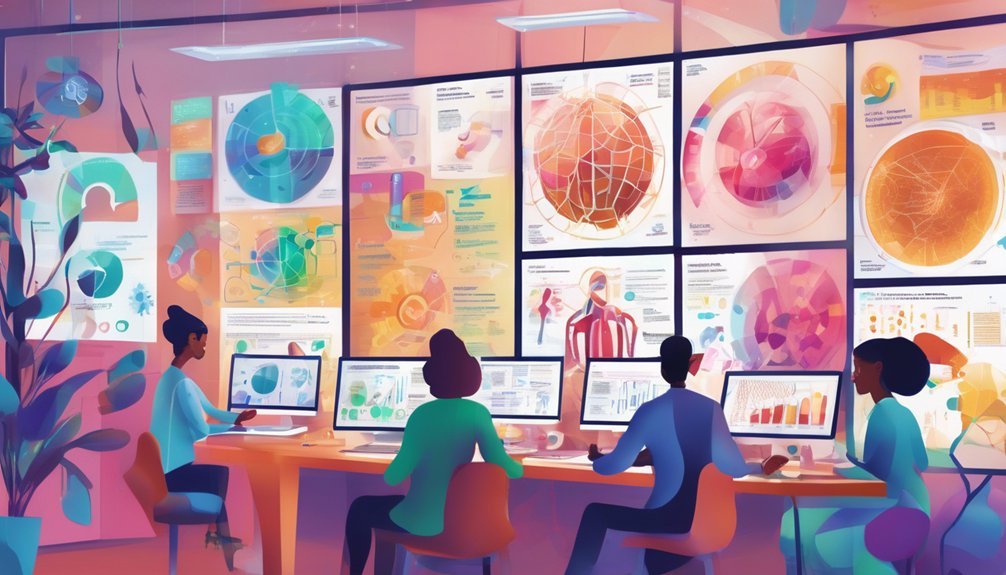Communicating lab research to cancer patients might seem daunting, but it’s essential for their understanding and involvement in treatment. You can break down complex information into simpler terms, fostering a connection that empowers patients. Imagine using storytelling and visuals to make this science relatable. What if you could transform the way patients perceive their treatment? The journey from the lab to the blog holds the key to unlocking this potential.
Key Takeaways
- Use patient-centric communication to prioritize needs and foster trust in sharing lab research findings.
- Simplify scientific language to make complex concepts more relatable and understandable for patients.
- Utilize storytelling to connect emotionally with patients, highlighting their experiences alongside research advancements.
- Incorporate visuals, such as infographics, to clarify intricate data and enhance patient engagement with research.
- Encourage feedback and dialogue through Q&A sessions and surveys to ensure patients feel valued and heard in the research process.
Understanding the Importance of Patient-Centric Communication

When you’re navigating the complexities of cancer treatment, effective communication can make all the difference in your journey.
Understanding patient perspectives is crucial; it ensures that your needs and feelings are at the forefront of discussions. When researchers and healthcare providers prioritize patient-centric communication, they create an environment where you feel heard and valued.
This approach fosters trust, enabling you to engage openly in your treatment plan. Effective messaging simplifies complex medical concepts, making them more relatable and understandable.
It empowers you to ask questions, voice concerns, and make informed decisions about your care. By embracing this communication style, you’re not just a patient but an active participant in your healing journey, leading to better outcomes and a stronger support network.
Simplifying Scientific Language for Better Engagement
Although scientific research can often feel overwhelming, simplifying the language used can significantly enhance your understanding and engagement.
By focusing on jargon reduction and offering layman explanations, you can make complex information more accessible.
Simplifying language and reducing jargon can significantly enhance accessibility to complex scientific information.
Here are three effective strategies to achieve this:
- Use Everyday Language: Replace technical terms with familiar words to make concepts relatable.
- Break Down Complex Ideas: Divide intricate subjects into smaller, digestible parts to improve comprehension.
- Provide Context: Use real-world examples to illustrate scientific principles, making them more relevant to daily life.
Utilizing Storytelling to Connect With Patients
Storytelling can transform the way you connect with cancer patients, making complex research feel more personal and relatable. By using narrative techniques, you can weave together stories that highlight the human side of scientific breakthroughs.
Share patient experiences or the journey of a researcher to create emotional resonance. When patients see themselves reflected in these stories, they’re more likely to engage with your work and understand its significance.
Focus on the challenges, triumphs, and the hope that research brings. This approach not only demystifies science but also fosters empathy and connection, encouraging patients to feel that they’re part of the journey.
Ultimately, storytelling empowers you to bridge the gap between lab research and the lives it impacts.
Incorporating Visuals to Enhance Understanding

Visuals can be a powerful tool in making complex cancer research more accessible and understandable for patients. By incorporating effective data visualization and infographic design, you can help patients grasp essential concepts quickly.
Visuals transform complex cancer research into accessible information, helping patients quickly understand essential concepts.
Here are three ways to enhance understanding through visuals:
- Simplify Complex Data: Use charts and graphs to break down intricate data, making it visually digestible.
- Highlight Key Information: Infographics can emphasize critical points, ensuring patients don’t miss vital information about their treatment options.
- Tell a Visual Story: Create a narrative arc through visuals that guide patients through the research process, making it relatable and engaging.
Leveraging Social Media for Wider Reach
Social media can be a game-changer for communicating lab research to cancer patients, reaching a broader audience and fostering community engagement.
By carefully choosing your platforms—like Facebook for community building or Twitter for real-time updates—you can tailor your message to fit each environment.
Don’t underestimate the power of hashtag strategies; they can help your posts gain visibility and connect with relevant conversations. Use specific hashtags related to cancer research or patient support to attract those who need your insights the most.
Engaging with patients through social media not only spreads awareness of your work but also empowers them with information, creating a supportive network that benefits everyone involved in the fight against cancer.
Encouraging Feedback and Continuous Dialogue
While sharing your lab’s research with cancer patients is crucial, creating a two-way conversation is equally important.
Establishing feedback loops and utilizing dialogue platforms can enhance understanding and trust. Here are three ways to encourage ongoing dialogue:
- Host Q&A Sessions: Organize regular sessions where patients can ask questions and share concerns directly with your team.
- Create Surveys: Use simple surveys to gather patients’ thoughts on your research, allowing them to express what matters most to them.
- Engage on Social Media: Actively respond to comments and messages, fostering a community that feels heard and valued.
Frequently Asked Questions
How Do I Find Credible Cancer Research Blogs?
To find credible cancer research blogs, evaluate their sources, check the author’s qualifications, and look for peer-reviewed references. Engage with communities discussing these blogs to gain insights into their research credibility and relevance.
Can Cancer Patients Contribute to Research Discussions?
Absolutely! Cancer patients can bring valuable patient insights to research discussions. By sharing their experiences, they foster meaningful research collaboration, ensuring studies address real needs and improve outcomes for themselves and others facing similar challenges.
What Platforms Are Best for Patient Engagement?
For patient engagement, consider using social media for real-time interaction, patient forums for shared experiences, email newsletters for updates, and video content for personal stories. These platforms can foster community and enhance understanding.
How Often Should I Update My Blog With New Research?
Think of your blog as a garden; regular watering keeps it thriving. Aim for bi-weekly updates on research to keep your audience engaged and informed. Consistent blog frequency nurtures curiosity and fosters a supportive community.
What Privacy Measures Should I Consider When Blogging?
When blogging, prioritize anonymity protection and data security. Use pseudonyms for individuals, avoid sharing sensitive details, and employ secure platforms. These measures help create a safe space for sharing valuable information while respecting everyone’s privacy.
Conclusion
In conclusion, prioritizing patient-centric communication can truly transform the way cancer research is shared. Did you know that 80% of patients prefer simple language over complex jargon? By simplifying our language, using storytelling, and incorporating visuals, you can make your research relatable and engaging. Embracing this approach not only builds trust but also empowers patients to take an active role in their treatment. Let’s bridge the gap between the lab and the patients who need this knowledge the most!





